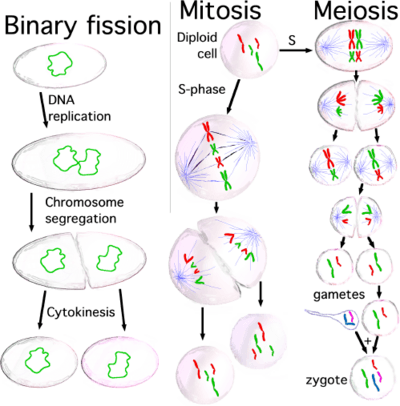Cell division facts for kids

Cell division is the process by which a cell, called the parent cell, divides into two cells, called daughter cells. When the cell divides, everything inside it divides also. The nucleus and the chromosomes divide, and the mitochondria divide also.
In mitosis, an ordinary body (somatic) cell divides to make two daughter cells.
In meiosis, a cell divides twice, to produce four gametes (sex cells). The first division of meiosis is a special kind of cell division called a reduction division because the number of chromosomes is halved. The second division of meiosis is similar to mitosis.
Cells are the 'building blocks' of life, and cell division is a basic feature of life. For simple unicellular organisms like Amoebozoa, one cell division reproduces the entire organism. On a larger scale, cell division can create offspring from multicellular organisms, such as plants that grow from cuttings. But most importantly, cell division enables organisms that are able to sexually reproduce to develop from the one-celled fertilised egg (zygote). Cell division also allows for continual renewal and repair of the organism.
Images for kids
-
Image of the mitotic spindle in a human cell showing microtubules in green, chromosomes (DNA) in blue, and kinetochores in red
See also
 In Spanish: División celular para niños
In Spanish: División celular para niños





